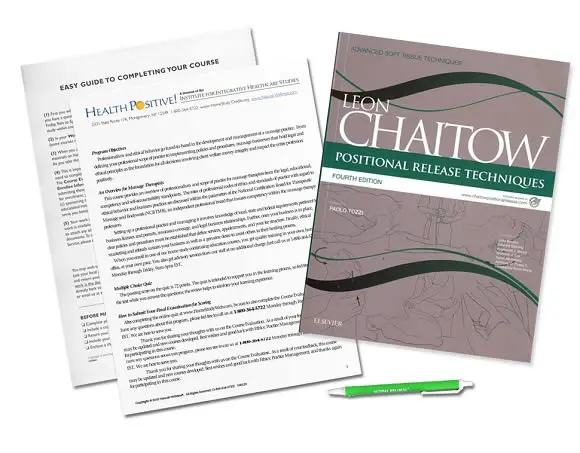
Positional release techniques are gentle manual treatments to relieve pain and discomfort, improving the overall health and functioning of the body by correcting imbalances of the musculoskeletal system. The advanced course covers all methods of spontaneous release by positioning. Theories and history of many different approaches are discussed and techniques are described in detail through illustrations and photographs. The associated online videos provide demonstrations of the techniques as well.
Also included in this continuing education course:
Brittany Eckis, LMT
2/28/2025
Doug Robinson, LMT
2/9/2025
Heather Nelson, LMT
1/5/2025
Bonnie Foster
12/29/2024
This course contains great material for enhancing my practice. Some of the reading can be tedious but the visuals and video support are great for clarification. Highly recommended!
Lorraine Scott
12/15/2024
This course provided a good overview in comparing and contrasting the different positional release techniques. I wish I'd had it years ago to provide a framework with which to evaluate them. Admittedly, I'm biased toward most articles by Leon Chaitow.

Sharon Burch holds a Masters Degree in Nursing and has been practicing as a nurse since 1974. She is currently a Registered Nurse in the state of Arkansas. Additionally, Ms. Burch studied under many of today's leaders in massage therapy and bodywork during the 1980s, became Nationally Certified through the NCBTMB in 1993 and holds a professional membership with the AMTA.
As founder of Health Positive!, Ms. Burch has created over 60 home study nursing and massage continuing education programs, performed over 65 public, live educational presentations, has written two published books, served as a member on the NCBTMB Continuing Education committee and was a founding member of the National Association of Nurse Massage Therapists.
Sharon is an instructor on many of the Institute's programs and has authored and co-authored various ethics courses and additional titles such as Touch for the Seriously Ill, Stress Reduction Through Bodywork, Staying Well – Naturally, Cardiopulmonary Health and Illness, Chronic Pain Management, Marketing Massage in Four Easy Steps, Preventing Medical Errors, HIV Update for Massage Therapists and Bodyworkers, Understanding HIV, Massage for Edema and more.


Take our free online course: Ethics Refresher
We will not rent/sell your email to anyone.
You'll also receive our newsletter and special offers.
Thank you! An email will be sent to the address provided with instructions on how to enroll in this 1 CE hour course - FREE!
If you do not see our email within a few minutes of signing up, please check your Spam/Junk folders it may have been delivered there instead of your inbox.
If, by chance, you still have not received it within 5 minutes, please call us at 1-800-364-5722, Monday-Friday, between 9am-12:30pm and 1:30pm-5pm EST for assistance.